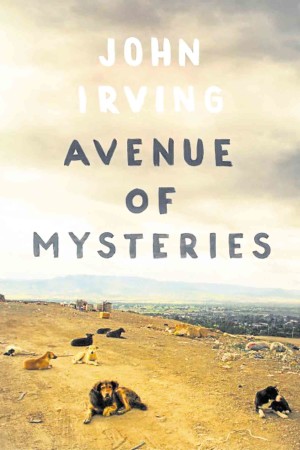TIME and place are slippery and sharp objects in the hands of John Irving. The product of this unexpected bloodletting is Irving’s 14th novel, “Avenue of Mysteries” (Simon & Schuster, New York, 2015, 460 pages).
The renowned American novelist’s new book is about a writer, the made-up fiftysomething Mexican novelist Juan Diego Guerrero.
Just like Juan Diego, Irving flits between fiction and fact, between the imagined and the real. “Avenue” is situated in the elusive place in between creating and knowing—for isn’t that where all novelists live and breathe?
Physically Juan Diego spends most of “Avenue” on a trip to the Philippines, moving from Manila and on to Bohol, El Nido, Laoag and Vigan, then going back to Manila; Manila Bay is “the unlit darkness.”
The Philippines Irving writes about is both unflattering and instantly recognizable. This is no distorted funhouse mirror version.
Bizarre childhood
But, narratively speaking, Juan Diego spends most of “Avenue” in the town of Oaxaca, Mexico. The Philippines reminds Juan Diego of his bizarre childhood living in a dump.
The novel slips back and forth seemingly uncontrollably between time periods and locations: “The way you remember or dream about your loved ones —the ones who are gone—you can’t stop their endings from jumping ahead of the rest of their stories. You don’t get to choose the chronology of what you dream, or the order of events in which you remember someone. In your mind—in your dreams, in your memories —sometimes the story begins with the epilogue.”
Self-taught genius
At 14 in 1970, Juan Diego is the self-taught genius of the dump—the “dump reader”— because he’s able to read on his own.
His 13-year-old sister Lupe speaks in a tongue that only Juan Diego can understand; she can also read minds and divine the future.
Irving begins his journey to magical realism early on in “Avenue” and the book takes a decidedly bolder dive into the surreal the more you read. Even without the seemingly supernatural elements, “Avenue” already boasts some powerfully quirky parts.

To mangle the name of a popular literary trope, “Avenue” features Chekhov’s Circus. Everybody and everything you encounter in Irving’s novel matters and means something. Since readers meet Juan Diego as a well-known adult writer, they hunger to find out how he got from the dump to Manila.
Oddball gathering
Along the way, readers will meet the religious man who wears Hawaiian shirts; the transvestite dwarf; the unnamed good gringo; the lion tamer; the unbelieving physician; and the other unusual characters.
The fellowship of “Avenue” is an oddball gathering worthy of Irving’s incandescent 1978 novel “The World According to Garp.” Readers will recognize familiar themes from books such as 1985’s “The Cider House Rules” and 1994’s “A Son of the Circus.” And so many things happen to this gathering, especially Juan Diego.
There’s a whole lot of book in “Avenue’s” 460 pages. It’s a complicated, challenging book that, like Juan Diego’s fictional fiction, invites a collision between beloved things: religion and faith, lust and love, rules and freedom, medicines and talismans.
A novel that winds around you but can also bite you like surprising kinds of boa constrictors, “Avenue” is also a deeply thought-out, impeccably written reflection on the writer’s process, with Irving writing Juan Diego writing others and so on.
Disorienting experience
Most of all, “Avenue” is about the revelation of remembrance, what happens when we confront our pasts completely, with all of the hidden edges becoming evident. The things we know can hurt us.
The readers experience the same thing Juan Diego experiences, and it is a disorienting, overwhelming experience. As “Avenue” swoops like a hungry vulture toward its white dwarf of an ending, readers will feel both helpless and hungry to find out how it all ties up together. Is Juan Diego remembering or dreaming? Are we?
Ultimately it is the doomed Lupe who says: “Remember this. We are the miracle—you and me. Not them. Just us. We are the miraculous ones.”
That is what John Irving’s “Avenue of Mysteries” reminds us: We are all miraculous ones, flying over the unlit darkness.
Available in hardcover from National Book Store